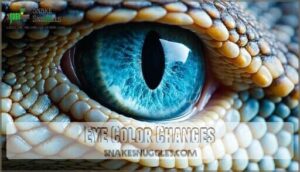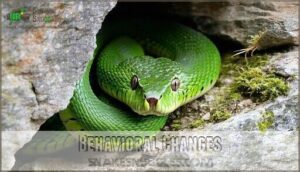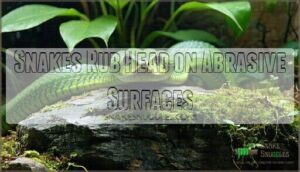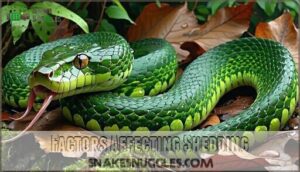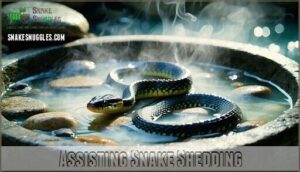This site is supported by our readers. We may earn a commission, at no cost to you, if you purchase through links.

You’ll notice their eyes turn milky blue first, then their skin becomes dull and tight.
They’ll start rubbing against rough surfaces to create a starting point, then wiggle through tight spaces to peel off the old skin in one piece – like pulling off a sock inside out.
This natural process, called ecdysis, happens more frequently in young, fast-growing snakes and less often in adults.
The whole cycle takes about two weeks from start to finish, and proper humidity makes all the difference between a clean shed and a patchy nightmare.
Table Of Contents
- Key Takeaways
- Snake Shedding Basics
- Signs of Snake Shedding
- Shedding Process Explained
- Factors Affecting Shedding
- Assisting Snake Shedding
- Frequently Asked Questions (FAQs)
- Why do snakes shed their skin?
- How long does snake shedding take?
- How do snakes shed?
- What are the stages of snake shedding?
- What happens if a snake doesn’t shed properly?
- What environmental factors affect snake shedding?
- Is it painful for snakes to shed their skin?
- How does snake skin shedding work?
- Do snakes go back to where they shed their skin?
- What triggers a snake to shed?
- Conclusion
Key Takeaways
- You’ll recognize shedding starts when your snake’s eyes turn milky blue and skin becomes dull – this pre-shed phase lasts 1-2 weeks before the actual skin peels off
- Your snake needs 50-70% humidity and proper temperature gradients (85-95°F warm side, 75-85°F cool side) for clean, complete sheds without stuck pieces
- You can expect young snakes to shed every 4-6 weeks due to rapid growth, while adults only shed 2-4 times yearly as their growth rate slows
- You’ll see your snake rub against rough surfaces and crawl through tight spaces to peel off the old skin in one piece – this natural behavior doesn’t require your intervention
Snake Shedding Basics
When your snake starts looking dull and cloudy-eyed, it’s getting ready to shed its skin like taking off an old sweater that no longer fits.
This natural process happens because snakes can’t stretch their outer skin layer as they grow, so they must replace it entirely to stay healthy and parasite-free.
Growth and Health Importance
When your snake sheds its skin, you’re witnessing nature’s ultimate renewal process. Essential ecdysis isn’t just cosmetic—it’s essential for snake health and their growth process.
Your snake’s old skin is like yesterday’s news—time to shed it and shine with fresh, healthy scales.
This skin rejuvenation removes worn-out layers that can’t stretch with your snake’s expanding body. Think of it like outgrowing your favorite jeans, except snakes get a complete wardrobe refresh.
Healthy molting also provides important parasite removal, eliminating mites and other unwanted hitchhikers. The snake shedding process promotes skin renewal while allowing proper circulation and preventing infections.
Healthy ecdysis keeps your serpent friend comfortable, disease-free, and ready for continued growth throughout their life.
Frequency and Age Factors
Your snake’s age dramatically shapes how often they’ll shed their skin.
Young snakes grow rapidly and shed every 4-6 weeks, while adults slow down to just 2-4 times yearly.
This age-dependent shedding rhythm reflects their changing metabolic rate and growth stages.
Here’s what affects snake shedding frequency:
- Juvenile sheds happen more often due to rapid body growth
- Adult frequency decreases as growth rate slows substantially
- Species differences create unique shedding intervals for each type
- Age influence determines how metabolic rate affects shedding timing
- Growth stages directly correlate with how often skin replacement occurs
Species-Dependent Shedding
You’ll find that shedding frequency varies dramatically between snake species, like comparing a sports car’s maintenance to a pickup truck’s.
Size variation plays a major role—corn snakes shed every 4-6 weeks when young, while adult boas might only shed 2-3 times yearly.
Genetic factors and species-specific shedding patterns mean your ball python won’t follow the same schedule as your king snake.
Habitat influence and diet effects further customize these cycles, with arboreal species showing unique patterns due to climbing behaviors and variable humidity exposure.
Understanding that juvenile snakes shed more frequently due to their rapid growth can also help predict shedding cycles.
Signs of Snake Shedding
You’ll notice several telltale signs when your snake is preparing to shed its skin.
These changes happen gradually over one to two weeks and include physical appearance shifts, eye color variations, and distinct behavioral modifications that signal the shedding process has begun.
Eye Color Changes
Your snake’s eyes reveal the first signs of approaching shed. The Cloudy Eye Stage begins when fluid builds between old and new eye layers, creating a hazy appearance.
Your snake’s cloudy eyes are nature’s way of saying "makeover time is coming soon.
Here’s what you’ll observe:
- Initial cloudiness appears as the Blue Tint Duration starts
- Eyes turn distinctly blue during peak shedding preparation
- Vision Impairment occurs as milky opacity develops
- Post-Shed Clarity returns just before skin removal begins
Watch for Retained Eye Caps if cloudiness persists after shedding completes.
Skin Texture and Color
Your snake’s Scale Appearance transforms dramatically during shedding.
Pre-Shed Dullness replaces their usual shine as colors fade to grayish tones.
Texture Variations make smooth scales feel rougher, while Shedding Color Changes wash out vibrant patterns.
Color Mutations become less visible during this phase.
After shedding completes, Scale Iridescence returns with stunning Post-Shed Vibrancy that makes your snake look brand new.
Behavioral Changes
Beyond the visible skin changes, you’ll observe distinct behavioral changes during snake shedding.
Shedding irritability becomes apparent as your snake shows aggression signs and seeks solitude.
Hiding duration extends considerably while appetite changes occur—they’ll refuse meals for days.
Activity levels drop as preshedding behavior kicks in.
You’ll spot them rubbing against rough surfaces, working to loosen old skin.
- Your snake becomes a temporary hermit, retreating to favorite hideouts until the process completes
More hiding and reclusive behavior
Temporary appetite loss
Mild aggression or irritability
These activity changes signal shedding’s approaching—let them handle their natural spa treatment undisturbed.
Maintaining proper humidity is key because low humidity causes issues.
Shedding Process Explained
When you understand the shedding process, you’ll see it’s like nature’s version of changing clothes.
Your snake’s body releases hormones that trigger the old skin to separate, then it rubs its head on rough surfaces and squeezes through tight spots to pull off the entire skin like peeling off a sock.
Hormonal Changes Triggering Shedding
Understanding hormone cascade mechanics helps you recognize what triggers your snake’s shedding process.
Ecdysis Hormones from the Pituitary Gland work with Thyroid Influence to orchestrate skin renewal:
- Growth hormones signal when skin becomes too restrictive for your snake’s expanding body
- Thyroid influence releases enzymes that separate old and new skin layers
- Seasonal Hormones activate Skin Receptors, creating fluid buildup between layers
These ecdysis triggers prepare your snake for successful molting by loosening cellular bonds naturally.
The process is also influenced by factors like temperature, feeding, and activity level, which affect the snake’s shedding frequency.
Snakes Rub Head on Abrasive Surfaces
You’ll spot your snake starting this critical phase when it begins pressing its head firmly against abrasive surface types like rough bark, rocks, or decorative logs.
This rubbing behavior isn’t random—it’s pure instinct driving shedding initiation. Your pet carefully selects textured surfaces that’ll help loosen the old skin without risking head trauma or scale damage prevention.
These natural behaviors are fascinating to watch as your snake methodically works the skin around its nose and lips. The snake shedding process relies on these abrasive surfaces to create that first vital tear.
To find the right materials, consider specialized shedding aids. Smart crawling mechanics guarantee the skin peels away cleanly, starting this amazing transformation.
Action Purpose
Snakes Crawl Through Tight Spaces to Shed Skin
After your snake rubs its head on rough surfaces, it’ll start the real work—squeezing through constricting spaces to complete the snake shedding process.
This crawling evolution creates perfect friction benefits as your pet moves through tight spots between rocks, branches, or hide decorations.
The shedding mechanics work like nature’s zipper system. As your snake navigates these spaces, the old skin catches and tears systematically from head to tail.
Abrasive surfaces provide the grip needed for skin loosening, while your snake’s natural crawling mechanics guarantee smooth snake ecdysis.
Many owners also utilize specialized shedding rocks to assist their snakes.
Think of it like peeling off a tight sock—the tighter the space, the easier the removal becomes.
- Constricting spaces create ideal friction for complete skin removal
- Rocks, branches, and decorations act as natural shedding tools
- Snake skin shedding happens systematically from snout to tail tip
Factors Affecting Shedding
Several factors influence how smoothly your snake sheds its skin, from humidity levels to age and growth rate.
Understanding these variables helps you create the perfect environment for a successful shed cycle.
Environmental Factors and Solutions
Your shedding environment can make or break your snake’s molt. Think of it like setting up a spa day – everything needs perfect conditions for success.
Humidity Control sits at the heart of smooth shedding. You’ll want 50-70% humidity, which you can achieve with regular misting or a humid hide filled with damp moss. Temperature Gradients matter too – your snake needs options. Create a warm basking spot around 90°F and a cooler retreat near 75°F.
A vital element is the proper hide environment for the snake. Your setup choices directly impact results:
- Substrate Choice: Coconut fiber or cypress mulch holds moisture better than aspen
- Enclosure Size: Adequate space prevents stress during vulnerable shedding periods
- Water Availability: Large, shallow bowls let snakes soak when they need relief
- Rough surfaces: Logs and rocks help snakes initiate the peeling process naturally
Low snake shedding humidity causes stuck sheds, while proper shedding environment management prevents most problems before they start.
Age and Species-Dependent Shedding
Age totally flips the shedding script for your snake.
Young snakes shed like they’re changing outfits—every 3-4 weeks because they’re growing so fast.
Adult snakes? They’re more like that friend who wears the same jacket for months, shedding just 2-4 times yearly.
Species variation makes things even more interesting.
Corn snakes shed more frequently than massive boas simply because size influences everything.
A juvenile ball python might shed monthly, while an adult reticulated python barely bothers twice a year.
These age-dependent shedding rhythms aren’t random—they’re driven by genetic factors and growth stages.
Your snake’s genetics determine its baseline shedding frequency, but age influences how often it actually happens.
Species-specific shedding patterns evolved for survival, not convenience.
To guarantee a healthy shed, understanding the snake shedding process is essential.
This knowledge helps in recognizing the normal shedding cycle and taking appropriate care.
Growth Rate and External Factors
Your snake’s growth journey is like a race car hitting different speeds throughout its life.
Diet Influence plays a starring role – well-fed snakes with quality nutrition experience faster growth and more frequent shedding cycles.
Environmental factors create the perfect storm for healthy snake shedding process success or failure.
Here’s what drives your snake’s shedding schedule:
- Metabolic Rate increases with warmer temperatures, speeding up growth and shedding frequency
- Seasonal Impact brings more sheds during warm months when metabolism peaks
- Habitat Quality with proper humidity prevents stuck sheds and complications
- Injury Effects can trigger unexpected shedding as the body repairs damaged skin
Age and size matter too – juveniles shed every few weeks while adults slow to just a few times yearly.
Poor environmental factors can throw this natural rhythm completely off track.
Assisting Snake Shedding
You can help your snake shed successfully by creating the right environment and watching for problems.
Think of it like setting up a spa day – your snake needs proper humidity, temperature, and some rough surfaces to rub against when it’s time to peel off that old skin, which is crucial for a successful shed.
Maintaining Proper Humidity Levels
Three fundamental elements create ideal snake shedding environments.
You’ll need humidity monitoring through hygrometer placement in your shedding enclosure—aim for 60-70% humidity levels.
Misting techniques help maintain proper humidity levels without overdoing it.
Your substrate choice matters too; cypress mulch retains moisture better than newspaper.
Think of humidity control as your snake’s best friend during this vulnerable time.
Too little leaves stuck skin patches, while excessive moisture invites unwanted bacterial guests.
Smart humidity monitoring transforms a stressful ordeal into a smooth passage for your scaly companion, and it’s all about finding the right balance to make the process as comfortable as possible, with proper humidity levels and the right substrate choice.
Providing Humid Hide and Water Bowl
After setting up proper humidity levels, you’ll want to create the perfect shedding station for your snake. Think of it as building a spa retreat right in their enclosure.
Humid hide benefits are game-changing for smooth snake shedding. Your snake needs a cozy retreat where moisture stays trapped, making that old skin peel off like magic. Choose a hide that’s just big enough for your snake to curl up inside—too large won’t hold humidity effectively.
Water bowl size matters more than you’d think. Pick one that’s about 1.5 times your snake’s width so they can soak comfortably when needed. Location importance can’t be overstated—place the humid hide on the warm side of your snake enclosure where heat helps activate the moisture.
Material safety and cleaning frequency go hand in hand for a healthy setup:
- Use sphagnum moss or paper towels (never cedar or pine)
- Replace bedding weekly or when soiled
- Scrub the water bowl every few days
- Check hide walls for mold growth
- Rinse everything with reptile-safe cleaners
Fresh water keeps your snake hydrated and ready for their next shed cycle. Remember that digital hygrometers are essential for accurate humidity monitoring.
Monitoring Temperatures and Snake Behavior
You’ll want to maintain steady temperature gradients between 85-95°F (warm side) and 75-85°F (cool side) using digital thermometers and thermostats.
Watch for behavioral cues like increased hiding frequency and pre-shed irritability—these signal approaching sheds.
Don’t worry if activity levels drop; it’s normal snake behavior.
| Temperature Zone | Ideal Range |
|---|---|
| Basking Spot | 85-95°F |
| Cool Side | 75-85°F |
| Night Temperature | Above 70°F |
| Surface Temperature | Monitor with heat gun |
Proper temperature control prevents shedding stress and guarantees smooth activity changes post-shed.
Frequently Asked Questions (FAQs)
Why do snakes shed their skin?
Snakes shed their skin because their outer layer doesn’t grow with their expanding body.
You’ll see them rub against rough surfaces to remove this tight, outgrown "jacket" that restricts movement and growth.
How long does snake shedding take?
Ever wonder why your snake seems stuck in slow motion?
The complete shedding process takes one to two weeks from start to finish.
You’ll notice dull skin and cloudy eyes first, then everything clears up before the actual skin peels off in one piece.
How do snakes shed?
Here’s how the process works: You’ll notice your snake starts rubbing against rough surfaces like rocks or branches.
They begin at their nose, peeling the old skin backward like removing a sock inside-out until it comes off completely, which is a complete and natural process.
What are the stages of snake shedding?
Like a butterfly breaking free from its chrysalis, you’ll witness three distinct phases.
Pre-shedding brings cloudy eyes and dull skin lasting one to two weeks.
During shedding, snakes rub against rough surfaces, starting from their head downward.
Post-shedding reveals vibrant colors and restored appetite, marking a significant change after the snake has gone through the shedding process.
What happens if a snake doesn’t shed properly?
When you’re dealing with a stuck shed, things can get messy fast.
Retained skin cuts off blood flow, causing infections, tissue death, or blindness if eye caps stay stuck.
You’ll need to increase humidity and gently assist removal to prevent further complications, such as blindness.
What environmental factors affect snake shedding?
Temperature, humidity, and lighting directly impact your snake’s shedding success.
You’ll need 50-70% humidity, proper temperature gradients, and stable conditions.
Low humidity causes stuck skin, while stress from poor environments disrupts the natural process completely.
Is it painful for snakes to shed their skin?
Shedding isn’t painful for snakes.
You’ll notice they might seem uncomfortable or irritable beforehand, but that’s just natural behavior.
The process itself feels like peeling off old clothes – relieving rather than painful.
How does snake skin shedding work?
Think of it as nature’s ultimate makeover – snakes outgrow their skin like you’d outgrow clothes.
Their outer layer can’t stretch with their growing body, so hormones trigger ecdysis.
The snake rubs against rough surfaces to peel off the old skin in one complete piece, revealing fresh, vibrant skin underneath.
Do snakes go back to where they shed their skin?
No, snakes don’t return to their shed skin.
Once they’ve rubbed it off using rocks or branches, they simply move on.
The old skin becomes just another piece of nature’s litter, eventually decomposing naturally.
What triggers a snake to shed?
Growth hormones trigger your snake’s shedding when its body outgrows the old skin.
You’ll notice this happens because snake skin doesn’t stretch like ours does—it’s like outgrowing your favorite jeans!
Conclusion
Understanding your snake’s shedding process explained becomes as natural as reading your pet’s body language once you know what to look for.
You’ve learned the telltale signs from milky eyes to dull skin, plus how proper humidity and temperature make all the difference.
With the right environment and patience, you’ll help your snake shed cleanly every time.
Remember, shedding problems usually mean environmental adjustments are needed, not veterinary intervention.
- https://www.britannica.com/science/Why-Do-Snakes-Shed-Their-Skin
- https://a-z-animals.com/animals/snake/how-often-do-snakes-shed/
- https://www.iowadnr.gov/news-release/2015-08-25/why-do-snakes-shed-their-skin
- https://wholeeartheducation.com/snakes-shedding-skin/
- https://www.blueplanetaquarium.com/education/why-do-snakes-shed-their-skin/

